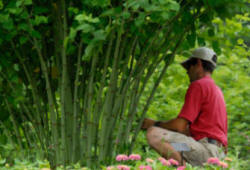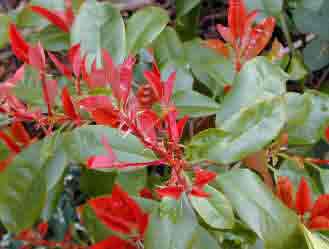How to kill Japanese Knotweed. Fallopia japonica control and treatment
Japanese Knotweed. Fallopia japonica var. japonica - Killing this invasive weed
Japanese Knotweed has been around for years. Many many years, for as a young boy, I used to use the hollow stalks for peashooters. My friends also used to 'smoke' the dead stalks in the winter, but that is another story!
Nowadays - some 55 years on - it has become public enemy number one insofar as weeds are concerned - it is not easy to kill or control! No longer a toy, but now a serious menace - so much so that there are strict rules (laws) governing what you can and cannot do if you have the wretched weed!
Japanese Knotweed treatment is essential as it can cost building contractors and developers dearly - sometimes many thousands of pounds if they have it on their building site. Control of Japanese Knotweed is essential.
Furthermore, if soil removed from a building site is proven to have any trace of Japanese Knotweed, then there are hefty fines that can be imposed, together with which there can by claims for compensation if the recipient's land becomes contaminated with Japanese Knotweed. You need to know how to kill and then control Japanese Knotweed.
 Killing Japanese Knotweed
Killing Japanese Knotweed
It is an invasive weed - spreading relentlessly through the UK after being introduced by some unsuspecting plant hunter as a highly desirable exotic garden plant in the middle of the nineteenth century. It does not spread by seed, for it is infertile. So all of the weed crops are seen throughout the UK were spread vegetively. They started their new life as a little bit of plant - maybe just a centimetre long that was transported to the new home! This can happen by way of topsoil import, being carried by birds or animals, or even by some unsuspecting and untidy human.
Certainly the transportation of building site excavation material and debris has been a contributory factor in the spread of Japanese Knotweed - as has the moving of general garden waste and rubbish from an infected area to a landfill site and thereafter to anywhere! Waterways, railway embankments, roadside verges, building sites, and of course, gardens, are all potential home to the Japanese Knotweed (- Fallopia japonica var. japonica).
In the native habitat, Japanese Knotweed has several 'predators' ranging from certain insects and a few diseases. These keep the 'problem' confined. In the UK, no such predators exist - though experiments suggest that a small insect can now be released, which will feed on the invasive weed, and hopefully control its spread if not in time totally eradicate it. Hopefully this insect will not then turn its attention to our ornamental varieties of Knotweeds - Persicarias and Polygonum!
As a garden weed, it can cause many problems in borders, or invade lawns - where the small fragments cut up by a lawn mower can then spread to other parts of the garden. These lawn mowing can also then be transported to other areas by way of household waste, or by fly-tipping garden maintenance operatives. Not all garden maintenance firms are fly-tippers of course!
Structural Damage caused by Japanese Knotweed
As well as being a 'weed' Japanese Knotweed is a serious problem in terms of structural damage. Once it has taken hold in ground near to buildings, it can soon cause problems of damage to buildings and certainly paved areas such as footpaths and patios. The underground stems (Rhizomes) are capable of diving down into the soil to a depth of 3 metres. Japanese Knotweed has even been found to be growing through the floorboards of a living room, after presumable growing under the foundations of the house! So - NOT to be ignored. One it takes hold, it is capable of spreading over an area of a few hundred metres within the space of a year!
Control and Treatment
If you find Japanese Knotweed (Fallopia japonica var japonica) on
your land, it is your responsibility to eradicate it - kill it -
control it, and prevent its further
spread. It is no use just phoning the local council. It is your
problem. You are responsible for your own
Japanese Knotweed Control. If of course,
it has been bought on to your land with a load of topsoil, or other
similar provable source, then you have a claim against the persons
who imported it onto your land. If you are in a new build property,
and suffer from the weed, then it may well be that there is a case
against your builder!
Don't try composting it, this will not kill
or control it - it is a waste of time and will lead to
problems if you then use that compost on your garden!
Weedkillers and how to Kill Japanese Knotweed
No weedkillers which are persistent in the ground should be used for controlling, treatment or killing Japanese Knotweed (Fallopia japonica var japonica). The two Japanese Knotweed Treatments which seem to offer the best solution in the UK are those with Glyphosate as main treatment ingredient, or weedkillers containing 2,4-D. Glyphosate is normally sold under the brand name of Roundup, Tumbleweed or Elimin8. There are others!
If you mean business with getting rid of Japanese Knotweed, then you
should invest in a good sprayer and use the concentrate form of the
weedkillers, rather than the silly little Ready to Use spray
cartons.
Glyphosate and 2,4-D can be used as a Japanese
Knotweed Treatment foliar spray - READ THE DIRECTIONS!. It
will need to be applied over 2-3 years to totally kill off the
Knotweed. This is a long term war, and for success you will need to
win several battles!
A further method that can be adopted - though rather time consuming
- is that of 'injecting' the stems with a strong solution made from
the concentrate. In this case, it will need to be around
plus ten times the recommended dilution
used for spraying. It has been said that the best time for
'injection, is during the Autumn months. We disagree with this, and
have seen this carried out very successfully in the full growing
season. The mixture can be directed directly into the hollows stems,
but far better to cut the cane stems to around 8-10in from the
ground - just below a visible joint. This will give you a hollow
receptacle into which you can pour approximately your mixture -
about 2-3 cm deep.
Any further re-growth - and there will be some, can then be foliar
sprayed in the normal manner.
Remember, both Glyphosate and 2,3-D are weedkillers that will also
kill off any of your prized plants if you accidentally spray them.
The same is true of your lawn!
Alternatively, you can enlist the help of a professional weed
clearance company.
Recommendations for for control of Japanese Knotweed for contractors and building development
The costs - direct and indirect - can be quite considerable if found
on building land. Directly, you can negotiate a better price or
price adjustment to take into account the expense of dealing with
Japanese Knotweed. You cannot simply ignore it, as a buyer or a
seller. By law, Japanese Knotweed has to be dealt with. Early
identification of Japanese Knotweed is essential in obtaining land
for development purposes, or land that has laid vacant and is now
being considered for development.
Soil which has been contaminated with Japanese Knotweed will need to
be treated before it can be re used on the site for landscape or
other purposes. The alternative being that untreated soil will need
to go to landfill - at cost. It is essential that your staff can
identify Japanese Knotweed or a consultant employed to advise.
Likewise, no topsoil should be allowed on to your site until there
has been an inspection of the load, and it is assessed as being free
form the weed.
A suitable member of staff should be delegated to ensure that all of
this is in place. It is an offence under the Wildlife and
Countryside act 1981 to allow Japanese Knotweed to be spread into
the wild. Together with this, all waste containing Japanese Knotweed
is subject to control under the Environmental Protection Act 1990.
Developers and contractors may get advice on the Environmental
hotline - 08708 506 506.
Best Selling Gardening Products
Popular Gardening Sections

Problems
Identify Weeds in The Garden - How to deal with weeds. Diseases and Pest which harm your garden and plants, learn how to prevent, deter and erradicate your garden problems.
Garden Problems
Pruning
Pruning Guide. Shrubs flower better with correct pruning. Many illustrations and examples of what to do - and when. Includes evergreens, roses, flowering shrubs, spring flowering shrubs and pruning for stem effect. This is our most viewed and comprehensive section,
Pruning
Gardening Businesses
Gardening Businesses listed in the UK counties and USA states. County and State Listings of businesses involved in Garden supplies and services. If you wish to be added to the Directory, please send us your information. Having problems, use the search box
Businesses
Gardening
In this section you will learn about Gardening Basics, Containers, Landscaping, Propagation and Soil.
Gardening
Gardening Gifts
Gardening Gifts and Reviews, Read Before you Buy
- Gardening Gifts Ideas
- Gifts For Her
- Gifts For Men
- Power Tool Gifts
- Cheap Gifts
- Personalised Gifts
- Wildlife Gifts
- Family Gifts



